

Earthquake Resistance Performance of a Multistorey RCC Frame Considering Two Different Positions of the Staircase
Shobhit Bajpai1 , R. K. Grover2
1PG Student, Department of Civil Engineering, Jabalpur Engineering College, Jabalpur, 482011
2Associate Professor, Department of Civil Engineering, Jabalpur Engineering College, Jabalpur, 482011

Abstract: The stairs have significant influence on the seismic lateral stiffness, vibration mode and internal force of frame beam column of the reinforced concrete frame structure. In this paper, 3 analysis models have been made by E-TABS. In these models, relevant analysis has been made about the influence of stairs in 10 storey building while it has no staircase, it is near the middle of the building and while it is near the corner of the building. Results from linear analysis show that in concrete structure, it is essential to consider the modelling of staircase as it causes additional stiffness and change in coordinate of center of rigidity. These effects can be evaluated in period, stiffness, base shear, lateral load and displacement of the structure.
Keywords: Seismic performance, Center of mass, Storey Drift, Base Shear, Stiffness.
I. INTRODUCTION
Staircase is an architectural element which has high potential to change structural behaviour especially moment frames against lateral forces, while it is usually neglected in structural design and it is not included in the model of structure. In fact, what is included in modelling structure of conventional buildings, are beams and columns around the staircase as a void and applied dead and live loads. Due to importance of the staircase in crisis and disasters as a way of escape and rescue routes and maintaining its function after the earthquake, it is necessary to pay special attention to the effects of the staircase in structural analysis and design, in a way that not only does no damage to structures, but also in the event of damage to the structures, this part of building remains intact and in service.
Earthquake is an impulsive event and acts quite differently. The force generated by seismic action of earthquake is different than other types of loads, such as, gravity, Dead load, Live load and wind load. It strikes the weakest spot in the whole structural frame building. Ignorance in structural design and poor quality & maintenance of construction result many weaknesses & faults in the structure member and Structural Building also, thus cause vulnerable damage to life and Structural property of building. In RC frame structural buildings, the primary structural system to resist Lateral & Gravity load are beams and columns. Besides, primary frame structural system, some structural member also contributes to lateral load resistance. These elements fall in the category of secondary systems. Secondary system can be structural secondary like staircase, structural partition etc and non structural secondary like storage tanks, machinery etc. A special case of structural secondary members which are normally designed for non seismic force; are concrete staircase.
Due to the complex modeling of the staircase, it is designed separately for non seismic and seismic forces. From a geometrical point of view, a stair is composed of inclined element (beam and slabs) and by short column. These elements contribute to increase stiffness of the building.
The effect of the staircase on the RC frame structure found in literature may be summarized as imparting discontinuity in the modeling, variation in failure of allied structural elements, contributing in non linear performance of buildings, modification of various seismic parameters such as change in the time period, storey stiffness, and storey displacement of the building have been considered.
The seismic analysis of structures by computer should meet the requirements of establishment of computation model, the necessary simplified calculation and processing should be consistent with the actual working condition of structure and should be considered the influence of staircase construction in calculation. This paper compares and analysis the frames structures at different positions of the staircase as per the provisions made in Indian seismic design code IS:1893 2016 and using linear static analysis methodology.
(IJRASET
ISSN: 2321 9653; IC Value: 45.98; SJ Impact Factor: 7.538 Volume 10 Issue IX Sep 2022 Available at www.ijraset.com

II. LITERATUREREVIEW
The main aim of this research is to study the effects of staircase on structure in design phase. In the following paragraph, the previous research is briefly reviewed.
1) Hoseini and Jafarnejad’s research on two reinforced concrete structure has shown that staircase causes the increase of the stiffness of the structure, base shear and internal force of structural elements around the staircase and reduction of the natural period of structure. Moreover, changing center of rigidity may lead to significant torsional effect. [1]
2) Cao et al. reported that the staircase increases the lateral stiffness, storey shear and overturning moment and decreases the period, based on the studies along the length of the staircase on two reinforced concrete structures [2]
3) Pratik Deshmukh presents the effects of staircase on the seismic performance of the RCC frame buildings of different heights and different plans have been studied. Generally, the stair model is not included in the analysis of RC frame buildings. Due to the rigidity of inclined slab and of short columns around staircase, beams and columns are often characterized by a high seismic demand. [3]
4) Results of Bastami et al. studies on a reinforced concrete structure with three different types of construction details of staircase have shown that bracing behaviour of staircase in longitudinal direction and its inclined shear wall behaviour in transverse direction causes the reduction of the natural period of structure and lateral displacement and increase in the stiffness of the structure. By increasing the structure height, effect of staircase on stiffness reduces. Eliminating the staircase from the model of structure is safe for columns and beams away the staircase, but it is unreliable for the ones near the staircase. The behaviour model with suspended stair is similar to the models without stair, but stair with this construction detail will be unstable during earthquakes.[4]
5) Singh and Choudhary’s studies on two types of geometrical plan configuration with RC structure and on 4 different heights have shown reduction in period of structure, increase in internal forces of landing beams and columns and reduction in inter storey drift ratio along two directions of models with staircase.[5]
6) Feng et al. analysed 18 RC structure models. They concluded that in the direction parallel to ladder running the stiffness of structure increases and the storey displacement ratio reduces, but in the direction perpendicular to the ladder running effects of staircase on structure can be neglected. Irrational layout of staircase may lead to torsional effect on structure. Staircase increases the internal forces in the members of structure, especially the columns at the location adjacent to the landing platform, where short column formed, while in the frames away the staircase the internal forces are reduced. To avoid the detrimental effects of staircase on structure, they proposed two details for isolating the staircase including full isolated staircase and semi isolated staircase.[6]
7) Tegos et al. studied five different types of staircases in a model. They concluded that staircase increases the stiffness of the structure, decreases structure’s natural
displacements in longitudinal direction and the influence of the vertical component of the earthquake in staircases with a free landing and helical one, is significant.[7]
and
III.METHOGOLOGY
IV.NUMERICALSTUDY
Parameters
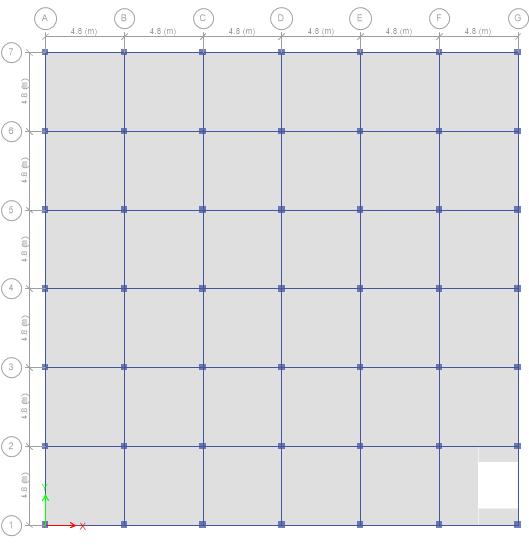
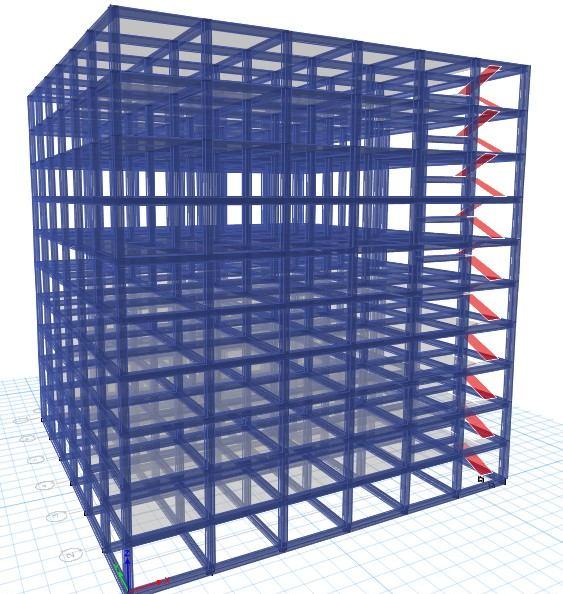
system of
taken as per IS
assumed to be 2 kN/m2 for a


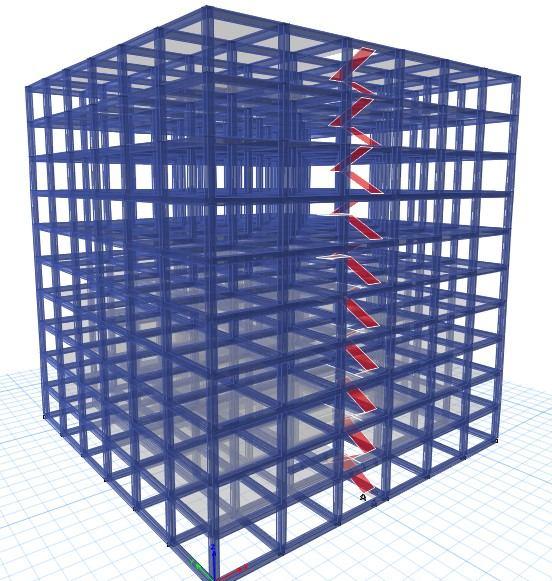
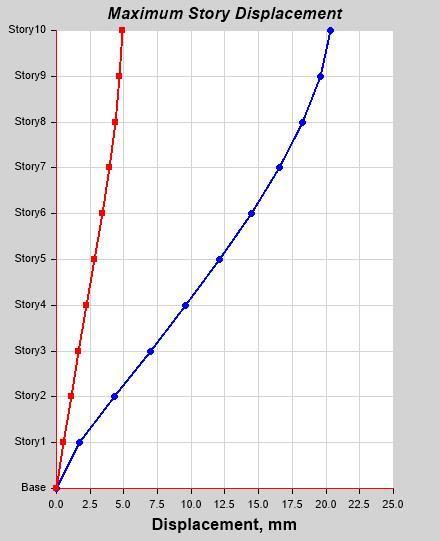
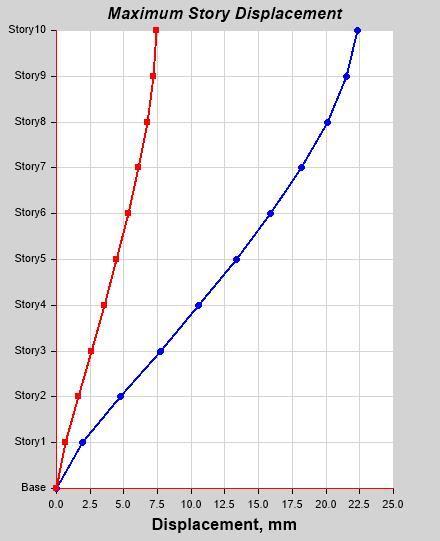
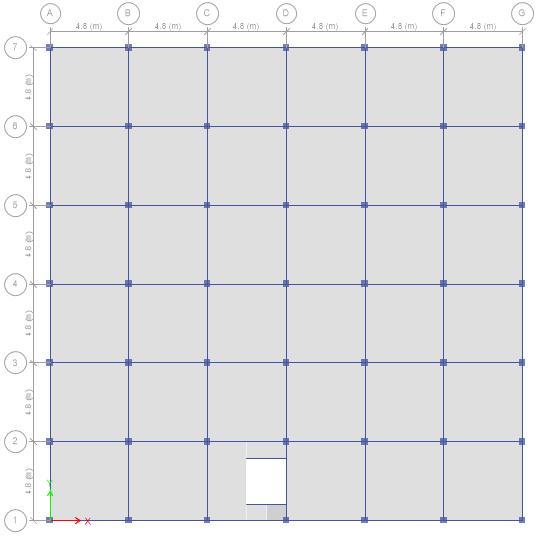
Storey
storey Displacement due to EQx & EQy (without staircase)
M
storey
Dir (stair in centre)
ISSN: 2321 9653; IC Value: 45.98; SJ Impact Factor: 7.538

10 Issue IX Sep 2022
at www.ijraset.com
TABLEV
due to EQx Max. storey Displacement due to EQy
Dir (stair in corner)
Dir (stair in centre)
Dir (stair in corner)
Storey10 20.104 20.332 22.361 15.073 19.272
Storey9 19.348 19.571 21.519 14.445 18.537
Storey8 18.067 18.276 20.099 13.44 17.304
Storey7 16.342 16.530 18.187 12.122 15.648
Storey6 14.276 14.438 15.894 10.565 13.665
Storey5 11.962 12.092 13.323 8.837 11.444
Storey4 9.477 9.573 10.565 7.001 9.06 Storey3 6.889 6.949 7.693 5.109 6.577
Storey2 4.26 4.281 4.775 3.199 4.053
Storey1 1.712 1.703 1.933 1.321 1.609 Base 0.000 0.000 0.000 0.000 0.000
TABLEVI
LATERAL LOAD TO STOREYS
Storey
Lateral load to storeys due to EQx & EQy (without staircase)
Lateral load to storeys due to EQy X Dir (stair in centre) X Dir (stair in corner) Y Dir (stair in centre) Y Dir (stair in corner) kN kN kN kN kN
Lateral load to storeys due to EQx
Storey10 287.879 303.296 437.780 389.518 299.683
Storey9 248.139 261.991 378.160 336.932 259.225
Storey8 196.061 207.005 298.793 266.218 204.820
Storey7 150.109 158.489 228.763 203.823 156.815
Storey6 110.284 116.441 168.071 149.747 115.211
Storey5 76.586 80.862 116.716 103.991 80.008
Storey4 49.015 51.751 74.698 66.554 51.205
Storey3 27.571 29.110 42.018 37.437 28.803
Storey2 12.253 12.938 18.675 16.639 12.801
Storey1 3.063 3.243 4.681 4.160 3.201
0.000 0.000 0.000 0.000 0.000
(EQy)
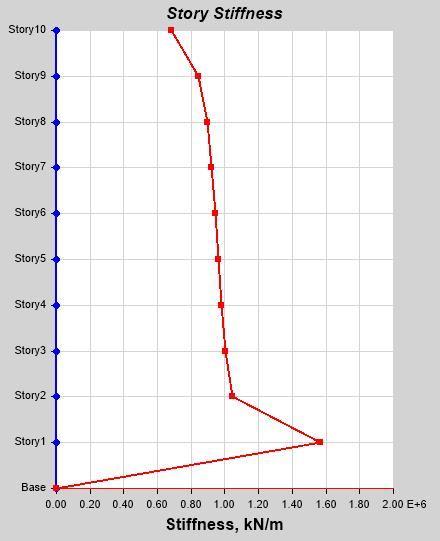
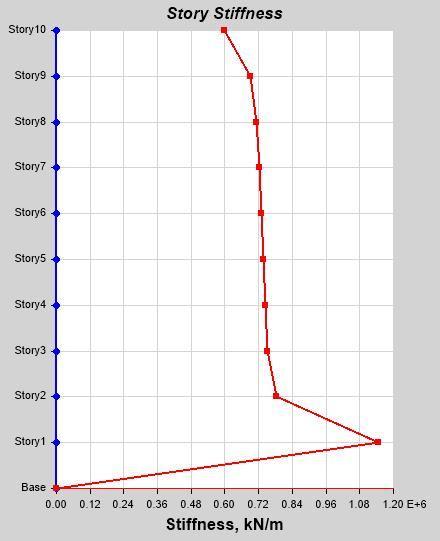
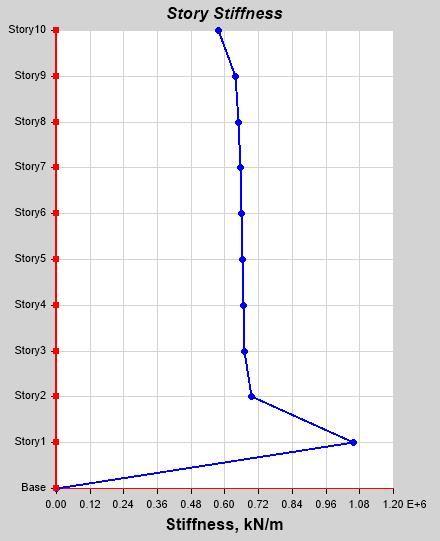
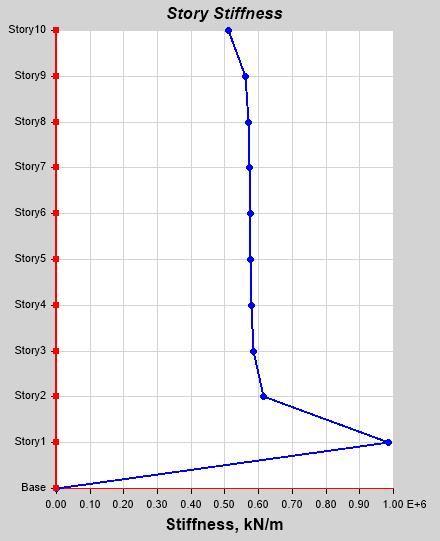

ISSN: 2321 9653; IC Value: 45.98; SJ Impact Factor: 7.538 Volume 10 Issue IX Sep 2022 Available at www.ijraset.com

TABLE VII
Storey stiffness in X & Y Dir. due to EQ loading
Storey Elevation Storey Stiffness due to EQx & EQy (without staircase)
Storey Stiffness due to EQx Storey Stiffness due to EQy X Dir (stair in centre) X Dir (stair in corner) Y Dir (stair in centre) Y Dir (stair in corner) m kN/m kN/m kN/m kN/m kN/m
Storey10 30 381073.341 510905.361 575533.123 683750.272 596946.312
Storey9 27 418800.618 562044.281 638290.133 840890.183 690729.757
Storey8 24 424933.176 569655.750 649632.110 894979.164 712895.931
Storey7 21 427542.449 572698.193 654560.997 922157.53 722672.812
Storey6 18 429271.456 574682.729 657891.803 941543.55 729395.408
Storey5 15 430801.041 576452.043 660868.486 959482.575 735531.139
Storey4 12 432565.611 578621.538 664140.600 979076.588 742451.845
Storey3 9 436234.687 583485.622 669113.931 1000994.765 752672.284
Storey2 6 454836.002 614053.313 693394.350 1046053.836 784400.695
Storey1 3 679024.647 983913.691 1056802.311 1564030.605 1146752.427
Base 0 0.000 0.000 0.000 0.000 0.000
VI.CONCLUSION
This paper found that the presence of staircase tremendously influences the design of beam & column in the periphery of staircase. Stairs have a significant contribution to the bidirectional lateral stiffness of the structure. Some of the major conclusion can be drawn from above analysis are listed below:
1) When staircase is in corner position the base shear in X dir is 1575 KN and 1225 KN when stair is in centre position, so it can be concluded that the base shear is more (approximately 28.5% in this model) in corner staircase position.
2) Maximum storey displacement due to earthquake in X direction (EQx) when staircase is in centre is 20.332 mm & 22.361 mm when stair is in corner so it can be concluded that displacement is more in corner position of stair (approx. 10% more).
3) When stair is in corner position the lateral load on 10th storey in X dir. is 437 KN & 303 KN when stair is in centre position due to EQx, so it can be concluded that the lateral load is more (approximately 44% in this model) in corner stair position.
4) When staircase is provided it contributes significantly in stiffness of structure. The stair models yield less displacement at the center position rather than the corner ones in the study. Similarly, while considering the case of lateral load, greater values are evolved for corner positions of stair which implies that the structure could be stiffer by assigning the staircases at centre positions rather than corner
VII. ACKNOWLEDGMENT
I would like to express my deep sense of gratitude & respect for my Guide Prof. R.K. Grover, Jabalpur Engineering College, Jabalpur for his evergreen expertise and inspiring guidance during the period of my entire course. It gives me an immense pleasure and pride to express my sincere thanks to Dr. Rajeev Chandak, HOD, Department of Civil Engineering and all Staff members of department for encouragement and helping me during my project work & for making all the facilities available in college.
REFERENCES
[1] Hoseini, M. H., Jafarnejad, H. (2015). Evaluating the performance of stairs’ elements in reinforced concrete structure during earthquakes, 2th National Conference on Earthquake, Qazvin, Iran.
[2] Cao, Z.W., Bian, C., Xu, C. Y. (2014). Analysis of the Interaction between Stair and Frame under Horizontal Earthquake Action Based on ETabs, In 2014 International Conference on Mechanics and Civil Engineering (icmce 14), Atlantis Press.
[3] Pratik Deshmukh, M. A. Banarase, "EFFECTS OF STAIRCASE ON THE SEISMIC PERFORMANCE OF RCC FRAME BUILDINGS", International Journal of Advance Engineering and Research Development, Volume 4, Issue 4, April 2017.
[4] Bastami, M., Talaeitaba, B., Salahi, S. (2011). Effects of modeling the staircase on conventional steel structure in the earthquake, 6th National Congress on Civil Engineering, Semnan, Iran
International
Science & Engineering Technology (IJRASET

ISSN: 2321 9653; IC Value: 45.98; SJ Impact Factor: 7.538 Volume 10 Issue IX Sep 2022 Available at www.ijraset.com
[5] Singh, N. S., Choudhury, S. (2012). Effects of staircase on the seismic performance of RCC frame building, International Journal of Engineering Science and Technology.
[6] Feng, Y., Wu, X., Xiong, Y., Li, C., Yang, W. (2013), Seismic performance analysis and design suggestion for frame buildings with cast in place staircases, Earthquake Engineering and Engineering Vibration, 12, 209 219.
[7] Tegos, I. A., Panoskaltsis, V. P., Tegou, S. D. (2013). Analysis and design of staircases against seismic loadings, 4th ECCOMAS thematic conference on computational methods in structural dynamics and earthquake engineering, Kos Island, Greece.
[8] IS:1893 (Part 1) 2016, “Criteria for Earthquake Resistant Design of Structures”, Part 1 General Provisions of Buildings, 6 th Rev., BIS, New Delhi.

